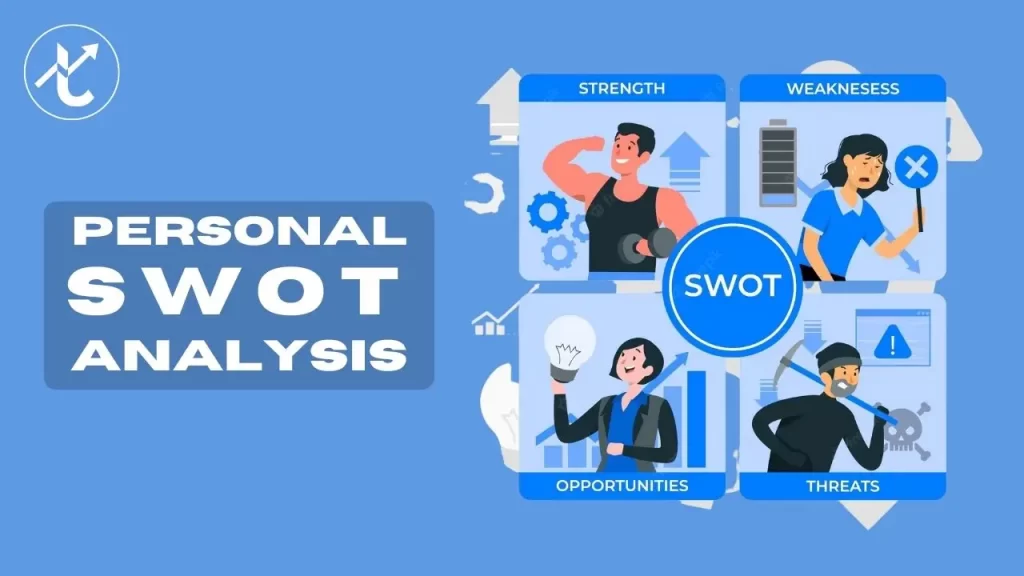Have you ever struggled to identify your strengths and weaknesses, opportunities and threats in your personal or professional life? You may find these elements and open the door to success and personal improvement by doing a personal SWOT analysis. This article will define a personal SWOT analysis, walk you through the process, and give examples to get you started.
What is a Personal SWOT Analysis?
An instrument for determining a person’s Strengths, Weaknesses, Opportunities, and Threats is the personal SWOT analysis. It is comparable to a SWOT analysis for businesses, except instead of emphasizing organizational planning, it focuses on professional and personal growth. You may better understand who you are, your strengths, your weaknesses, and your potential for progress by conducting a personal SWOT analysis.
How to do a Personal SWOT Analysis
Identify Your Strengths
- Find your strengths as the first step in a personal SWOT analysis. These are the abilities and characteristics that set you apart from others. Consider your strengths, your most admirable qualities, and your natural talents. To help you determine your strengths, consider the following questions:
- What abilities do I possess that are useful in both my personal and professional life?
- What distinguishing traits do I have that set me apart from others?
- What do other people praise about me?
- What hobbies or jobs do I like to do?
Identify Your Weaknesses
- Finding your shortcomings is the next stage. These are areas where you might struggle or have room for improvement. Consider any areas where you may struggle or where you have received criticism for improvement. Here are some inquiries to assist you pinpoint your areas for improvement:
- What essential abilities do I lack for my personal or professional life?
- What areas do I find difficult?
- What suggestions have I gotten for improvement?
- What hobbies or tasks do I find difficult?
Recognize Your Opportunities
- Finding your weaknesses is the following step. These are the areas where you could have trouble or where you could do better. Think about any areas where you might struggle or where you’ve gotten feedback on how to do better. Here are some questions to help you identify your areas for development:
- What fundamental skills do I need to succeed in my personal or professional life?
- What subjects do I struggle with?
- What recommendations have I received for development?
- What activities or jobs do I find challenging?
Identify Your Threats
- Threat identification is the last phase. These are outside variables that might obstruct your development or success. Consider the outside elements that can jeopardize your personal or professional objectives. To help you recognize your threats, consider the following questions:
- What outside variables might interfere with my personal or professional objectives?
- What difficulties or hurdles must I overcome?
- What developments in my industry might hurt me?
- What opportunities or resources am I missing out on?
Examples of Personal SWOT Analysis
To help you get started, here are some examples of personal SWOT analysis:
Example 1 | Sarah, a new college grad seeking employment in marketing
- Strengths
Sarah is well organized, has a strong sense of communication, and has social media marketing experience. - Weaknesses
Sarah’s weaknesses include a lack of experience with conventional marketing, a lack of graphic design expertise, and a tendency to be unsure of herself. - Opportunities
Opportunities include enrolling in a graphic design course to hone her talents, going to networking functions to meet people working in the marketing sector, and submitting an application for marketing internships to obtain experience. - Threats
Sarah might have trouble finding a job in a crowded market because the marketing business is so competitive.
Example 2 | John is a freelance writer
- Strengths
John is a skilled writer with experience in a wide range of fields and a substantial body of published work. - Weaknesses
John has some self-promotional issues, little knowledge with SEO, and occasionally has trouble meeting deadlines. - Opportunities
Opportunities exist for John to learn more about SEO, network with other independent writers and editors to discover new clients, and build a personal website to display his work and draw in new customers. - Threats
John might have trouble finding a continuous stream of work because the freelance writing industry can be volatile.
Example 3 | Maria, a college student, isn’t sure what her major will be
- Strengths
Maria is a top student, a natural leader, and she is skilled at critical thought. - Weaknesses
Maria’s weaknesses include a tendency to procrastinate when it comes to making crucial decisions, a lack of extensive knowledge in several areas, and issues with time management. - Opportunities
Maria might enroll in classes relating to her interests, consult with professors and advisors for guidance, and join groups and organizations focused on various majors to expand her knowledge and experience. - Threats
Maria might experience pressure from her family or societal norms to select a specific subject, and she might have difficulty finding employment in a competitive market once she graduates.
Benefits of a Personal SWOT Analysis
You can get understanding and insight into your personal and professional life by conducting a personal SWOT analysis. You can gain a better understanding of yourself and your potential for development by analyzing your strengths, flaws, opportunities, and threats. A personal SWOT analysis has some advantages, such as:
- Greater self-awareness and understanding
- Increased assurance in your abilities
- Identifying potential growth and improvement areas
- Better ability to make decisions
- Better planning and goal-setting
Conclusion
Anyone wishing to enhance their personal or professional life should consider conducting a personal SWOT analysis. Gaining clarity and understanding into your potential for development and achievement can be accomplished by identifying your strengths, flaws, opportunities, and dangers. Use the procedures and examples in this article to conduct your own SWOT analysis and learn how it can assist you in achieving your objectives.




